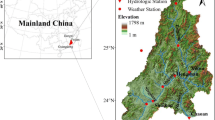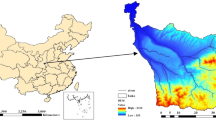Abstract
Non-point source (NPS) pollution has become a vital contaminant source affecting the water environment because of its wide distribution, hydrodynamic complexity, and difficulty in prevention and control. In this study, the identification and evaluation of NPS pollution risk based on landscape pattern were carried out in the Hanjiang River basin above Ankang hydrological section, Shaanxi province, China. Landscape distribution information was obtained through land use data, analyzing the contribution of “source-sink” landscape to NPS pollution through the location-weighted landscape contrast index. Using the NPS pollution risk index to identify and evaluate the regional NPS pollution risk considering the slope, cost distance, soil erosion, and precipitation erosion affect migration of pollutants. The results showed that (i) the pollution risk was generally high in the whole watershed, and the sub-watersheds dominated by “source” landscapes account for 74.61% of the whole basin; (ii) the high-risk areas were distributed in the central, eastern, and western regions of the river basin; the extremely high-risk areas accounted for 12.7% of the whole watershed; and the southern and northern regions were dominated by forestland and grassland with little pollution risk; (iii) “source” landscapes were mostly distributed in areas close to the river course, which had a great impact on environment, and the landscape pattern units near the water body needed to be further adjusted to reduce the influence of NPS pollution.












Similar content being viewed by others
Data Availability
The datasets used and/or analysed during the current study are available from the corresponding author on reasonable request.
References
Banadkooki FB, Ehteram M, Ahmed AN, Teo FY, Ebrahimi M, Fai CM, El-Shafie A (2020) Suspended sediment load prediction using artificial neural network and ant lion optimization algorithm. Environ Sci Pollut Res 27:1–23
Bu H, Meng W, Zhang Y, Wan J (2014) Relationships between land use patterns and water quality in the Taizi River basin, China. Ecol Indic 41:187–197
Cai H, Lin GM, Kang WH (2018) The effects of sloping landscape features on water quality in the upper and middle reaches of the Chishui River Watershed. Geogr Res 37:704–716 (in Chinese)
Chen LD, Fu BJ, Xu JY, Gong J (2003) Location-weighted landscape contrast index: a scale independent approach for landscape pattern evaluation based on “Source-Sink” ecological processes. Acta Ecol Sin 23(11):2407–2413 (in Chinese)
Cheng H, Hu Y, Zhao J (2009) Meeting China’s water shortage crisis: current practices and challenges. Environ Sci Technol 43(2):240–244
Chow MF, Yusop Z, Teo FY (2016) Evaluation of stormwater runoff quality during monsoon and inter-monsoon seasons at tropical urban catchments. Int J River Basin Manag 14(1):75–82
Fernandes ACP, Sanches FLF, Rui MVC, Pacheco FAL (2019) The role of landscape configuration, season, and distance from contaminant sources on the degradation of stream water quality in urban catchments. Water 11:2025–2044
Griffifith JA (2002) Geographic techniques and recent applications of remote sensing to landscape-water quality studies. Water Air Soil Pollut 138:181–197
Huang N, Wang YH, Lin T, Liu QM (2016) Regulation framework of watershed landscape pattern for non-point source pollution control based on “source-sink” theory: a case study in the watershed of Maluan Bay, Xiamen City, China. Chin J Appl Ecol 27(10):3325–3334 (in Chinese)
Jia YX, Shuai H, Han LF (2020) Zonation on non-point source pollution risk in the lower reaches of Zijiang River based on the "source-sink" theory. Chin J Appl Ecol 31(10):3518–3528 (in Chinese)
Jiang MZ, Chen HY, Chen QH, Wu HY (2014) Study of landscape patterns of variation and optimization based on non-point source pollution control in an estuary. Mar Pollut Bull 87(1-2):88–97
Li JK, Hao GR, Li S, Peng K, Song J (2020) Analysis of non-point source pollution characteristics in Shaanxi section of Hanjiang River Basin. J Xi'an Univ of Technol 36(03):275–285 (in Chinese)
Li JK, Peng K, Hao GR, Li HE, Li S (2021) Research progress on quantification and control of non-point source pollution load in the Yellow River Basin. Water Resources Protection 37(1):90–102 (in Chinese)
Liu RM, Yang ZF, Ding XW, Shen ZY, Wu X, Liu F (2006) Effect of land use/ cover change on pollution load of non-point source in upper reach of Yangtze River Basin. Environ Sci 27(12):2709–2714 (in Chinese)
Liu F, Shen ZY, Liu RM (2009) The agricultural non-point sources pollution in the upper reaches of the Yangtze River based on source-sink ecological process. Acta Ecol Sin 29(6):3271–3277 (in Chinese)
Mattikalli NM, Richards KS (1996) Estimation of surface water quality changes in response to land use change: application of the export coefficient model using remote sensing and geographical information system. J Environ Manag 48:263–282
Neill RV, Riitters KH, Wickham JD, Bruce K (1999) Landscape pattern metrics and regional assessment. Ecosyst Health 5(4):225–233
Othman F, Alaaeldin ME, Seyam M, Ahmed AN, Teo FY, Ming FC, Afan HA, Sherif M, Sefelnasr A, El-Shafie A (2020) Efficient river water quality index prediction considering minimal number of inputs variables. Eng Appl Comput Fluid Mech 14:751–763
Qian Y, Sun L, Chen DK, Liao JF, Tang LN, Sun Q (2021) The response of the migration of non-point source pollution to land use change in a typical small watershed in a semi-urbanized area. Sci Total Environ 785:147387
Shen ZY, Hou XS, Li W, Aini G (2014) Relating landscape characteristics to non-point source pollution in a typical urbanized watershed in the municipality of Beijing. Landsc Urban Plan 123:96–107
Wang SL, Wang XK, Xu D (2007) Advances in the prediction models of agricultural non-point source pollution. Trans Chinese Soc Agric Eng 5:265–271 (in Chinese)
Wang XP, Zhang F, Li XH, Cao C, Guo M (2017) Correlation analysis between the spatial characteristics of land use/cover landscape pattern and surface-water quality in the Ebinur Lake area. Acta Ecol Sin 37(22):7438–7452 (in Chinese)
Wang RJ, Wang QB, Dong LS, Zhang JF (2021) Cleaner agricultural production in drinking-water source areas for the control of non-point source pollution in China. J Environ Manag 285:112096
Wu JH, Lu J (2019) Landscape patterns regulate non-point source nutrient pollution in an agricultural watershed. Sci Total Environ 669:377–388
Xu F, Zhou XC, Meng QY, Zhang Y (2020) Remote sensing identification and evaluation of non-point source pollution risk of drinking water source based on “source-sink” landscape. Acta Ecol Sin 40(08):2609–2620 (in Chinese)
Xu QY, Wang P, Shu W, Ding MJ, Zhang H (2021) Influence of landscape structures on river water quality at multiple spatial scales: A case study of the Yuan river watershed, China. Ecol Indic 121:107226
Yue J, Wang YL, Li GC, Wu JS (2007) The conceptual framework of watershed landscape optimization concerning water environmental protection. Prog Geogr 26(3):38–46
Zhou HP, Gao C, Zhu XD (2005) Identification of critical source areas: an efficient way for agricultural non-point source pollution control. Acta Ecol Sin 12:3368–3374 (in Chinese)
Zhou L, Xu JG, Sun DJ, Ni TH (2013) Spatial heterogeneity and classified control of agricultural non-point source pollution in Huaihe River Basin. Chinese J Environ Sci 34(02):547–554 (in Chinese)
Zhou L, Li LZ, Huang JK (2021) The river chief system and agricultural non-point source water pollution control in China. J Integr Agric 5(20):1382–1395
Acknowledgements
We gratefully thank all the members of the research group on Non-point Source Pollution Control of the State Key Laboratory of Eco-hydraulics in Northwest Arid Region of China for their efforts in data collation.
Funding
This research was supported by the Key Research and Development Project of Shaanxi Province (2019ZDLSF06-01).
Author information
Authors and Affiliations
Contributions
Y. L., J. L., and J. X. contributed to the study conception and design. Material preparation, data collection, and analysis were performed by Y. L., J. L., and G. H. The first draft of the manuscript was written by Y. L. and F. T. All authors read and approved the final manuscript.
Corresponding author
Ethics declarations
Ethics approval and consent to participate
Not applicable
Consent for publication
Not applicable
Competing interests
The authors declare no competing interests.
Additional information
Responsible Editor: Xianliang Yi
Publisher’s note
Springer Nature remains neutral with regard to jurisdictional claims in published maps and institutional affiliations.
Rights and permissions
About this article
Cite this article
Liu, w., Li, Jk., Xia, J. et al. Risk assessment of non-point source pollution based on landscape pattern in the Hanjiang River basin, China. Environ Sci Pollut Res 28, 64322–64336 (2021). https://doi.org/10.1007/s11356-021-15603-w
Received:
Accepted:
Published:
Issue Date:
DOI: https://doi.org/10.1007/s11356-021-15603-w




